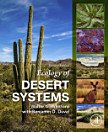Ecology of Desert Systems
Walter G. Whitford
Mar 2002 · Elsevier
4.0star
3 reviewsreport
Ebook
343
Pages
family_home
Eligible
info
reportRatings and reviews aren’t verified Learn More
About this ebook
Conventional wisdom considers deserts stark, harsh regions that support few living things. Most people also believe that water alone makes the desert bloom. Ecology of Desert Systems challenges these conventional views. This volume explores a broad range of topics of interest to ecosystem, population, community, and physiological ecologists. Climate, weather patterns, geomorphology, and wind and water processes are examined as variables that affect the distribution of biota through fundamental ecosystem processes. Descriptions of morphological, behavioral, and physiological adaptations of desert biota illuminate, through the lens of patch dynamics, principles for understanding observed patterns of primary production, nutrient cycling, and the effects of consumers. Desertification, and the techniques for monitoring and quantifying it, is examined within the framework of desert ecosystem patterns and processes. * Focuses on the interactions of climate, soil, and biota along a spectrum of spatial and temporal scales* Details the role of animals in desert ecosystems and landscape processes* Examines watershed scale processes, the ecology of ephemeral lakes, and the ecological changes identified with desertification* Outlines the fundamental concepts relevant to sustainable development of arid lands
Ratings and reviews
4.0
3 reviews
About the author
Professor Walter G. Whitford received his PhD from the University of Rhode Island in Physiolgical-Ecology. He spent the next fifty years working in the Chihuahuan Desert as a faculty member in Biology at New Mexico State University (NMSU) where he was principal investigator in the Desert Biome Program which was part of the International Biological Program. His research focused on field experiments and studies of termites and seed harvesting ants. That program stimulated his commitment to the importance of soil in arid ecosystems and the organisms that are involved in nutrient cycling. He also served as the first principal investigator for the Jornada Long Term Ecological Research Program. As principal investigator, he published more than 150 papers in peer reviewed journals dealing with most aspects of desert ecology. In 1993, he left the university to work as a senior research ecologist with the U. S. Environmental Protection Agency with a focus on monitoring and assessing the health of arid ecosystems. After retiring from the EPA he produced the first edition of Ecology of Desert Systems and continued to teach and do research in the Chihuahuan Desert. While a professor, he did research in Israel and Australia, evaluated arid lands research programs in South Africa, and organized a symposium on the Atacama and long-term ecological research in Chile. Before embarking on the 2nd edition of Ecology of Desert Systems, he was author or co-author of more than 300 peer-reviewed publications.
Rate this ebook
Tell us what you think.
Reading information
Smartphones and tablets
Install the Google Play Books app for Android and iPad/iPhone. It syncs automatically with your account and allows you to read online or offline wherever you are.
Laptops and computers
You can listen to audiobooks purchased on Google Play using your computer's web browser.
eReaders and other devices
To read on e-ink devices like Kobo eReaders, you'll need to download a file and transfer it to your device. Follow the detailed Help Center instructions to transfer the files to supported eReaders.





